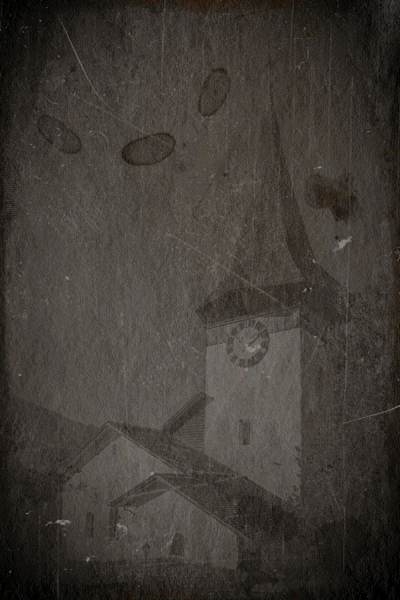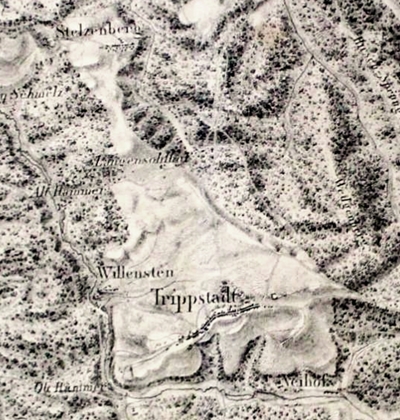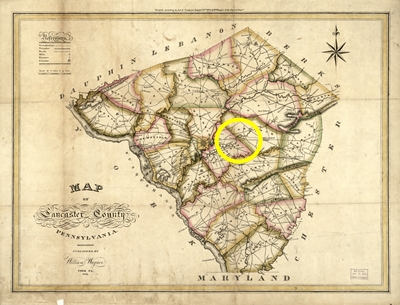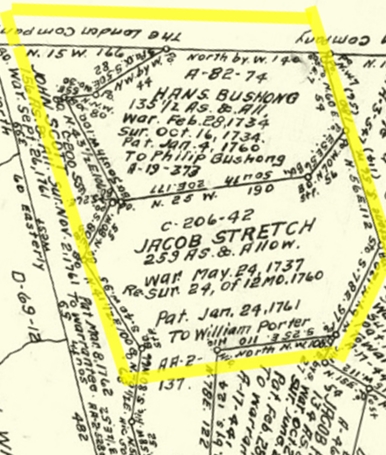














|
|
Our Swiss Family Bushong
(Unsere Schweizerische Boschŭng)
Of the Simmental
Part Two:The Original Bushong in America
By Rick Bushong
January 22, 2015
Updated, revised and expanded May, 2018
|
The Oberwil Reformed Church, where Hans III, was baptized.
Click to enlarge original. Compliments of Wikipedia, photograph by By WillYs Fotowerkstatt
|
Hans John Boschŭng III
 *
Hans "John" Boschŭng *
Hans "John" Boschŭng III | |
Anna Maria Boschung |
1661- before 1734 | | About 1662- before 1734 |
*From church book, 1661, in the clerics hand.
Married about 1681
Their children
- Anna Elisabeth Boschung
- Hanss Geoerg Boschung
- Hans John Bushong IV
- Johann Nicholas Bushong
- Andreas Boschung
- Eva Boschung
|
Who was the original or first Bushong in America? From many genealogists and sources old and new, there could be a lot of different answers. John Bushong? But which one? Maybe Jean Bushong? Maybe even Jean Beauchamp, from France? But mythology aside, there is only one original American immigrant Bushong and that is Hans Boschŭng III or as he was known in Pennsylvania, John Buschong.1
Hans Boschŭng III in Switzerland

Hans, III, baptism record, June 5, 1661 from church books at the St. Mauritus Church in Oberwil. |
|
Hans is shown to have immigrated to America in 1719, by Daniel Rupp in his Thirty Thousand Names book published 1876.1 Mr. Rupp listed a John Buschong who was living in Pennsylvania and likely owned property in 1719. This would be Hans Boschŭng III, a Swiss-born immigrant, who had left Switzerland for the Palatinate region of Germany almost forty years earlier. Then in 1719, he sailed to Pennsylvania.
Hans John Boschŭng III was born in Oberwil, Simmental, Bern, Switzerland, in 1661. The first of five sons and four daughters for Hans Boschung II and Anna Stocker, he was baptized June 5, 1661, in Oberwil's St. Mauritus Church.2 His life growing up in the Simmen Valley, can only be imagined, except we know he left as a young man. By 1682,3 he was in Minfeld, in the Germersheim District, Rheinland-Pfalz, Germany, where by then, he had found a wife and they had a daughter, It is uncertain if any other family members left at the same time. However his parents both died in Oberwil.2 Yet what could have caused him to leave his family, home and beautiful Simmen Valley? He was after all, the first-born son and by traditional standards, would certainly have been in line for a good portion of the family's Oberwil estate, assuming there was one.
|
There is always a chance that as a young man he diverged from the family's Reformed religion. To this, the very founder of the Amish sect, Jacob Amman, was born in Erlenbach, only six miles (10km) from Oberwil.4 They are an offshoot of the Mennonites, both of which are Anabaptists. Born in 1644, Mr Amman was just seventeen years older than Hans and they easily could have associated. Also with Mr. Amman growing up and living in the Simmental, it was inevitably home to many Anabaptists. Perhaps a young and possibly headstrong Hans, was caught up in the religious fervor? Because he left around 1680, and it was June of that year,4 when Canton Bern began clamping down on the Amish. They issued a proclamation demanding that Mr. Amman and other believers recant and leave Switzerland.4
Except an Anabaptist conversion for Hans would appear to be a brief, if not an unlikely occurrence, since at least three of his children, Hans IV, Nicholas, and daughter, Eva are shown to be of the Reformed faith. For example, Nicholas' children were all baptized within a month or so of birth, and son Andreas was baptized when he was but five days old.6 Then Nicholas' sister, Eva, was confirmed in 1719,12 in the same Waldfischbach Reformed Church as Andreas was baptized in. So if Hans III, became an Anabaptist, he would have changed back within a few years. Regardless, in Hans' early life as well as his life in America, there were always Anabaptists of various sects close by.
|
|
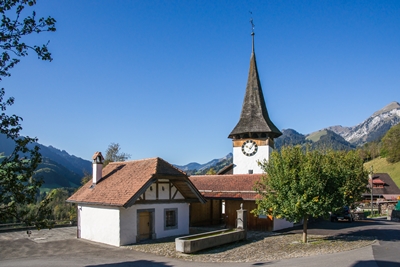
St. Mauritus Church in Oberwil, where Hans was baptized
Compliments of Wikipedia, photograph by By WillYs Fotowerkstatt
|
|
The entrance to the Simmen Valley, in Bern, Switzerland.
|
|
Nevertheless, he left Switzerland and began a sojourn that would, some forty years later, result in his voyage to America. The first place outside of Switzerland, where Hans III, is documented is in Minfeld, Germany. It is a municipality in the district of Germersheim, in Rhineland-Palatinate,5 and here we find Hans married to Anna Maria, baptizing their first daughter, Anna Elisabeth Boschung on February 2, 1682.3 They are noted there again, July 19, 1684, with the birth of a son, Hannss Geoerg Boschung.3
From this, we can assume that sons, Hans John Boschung IV, and Johann Nicholas Boschung, born in 1691 and around 1692, respectively, were also born there. Their father's age would have been about 30 when his namesake, Hans IV was born. Another son, Andreas Boschung, date of birth unknown, was also born in Germany, and he is listed as Nicholas' brother on a January 30, 1717,6 when he was a witness for his namesake, Johann Andreas' baptism.
|
However sometime in 1699, Hans was granted permission to relocate to a different district and the family moved some 45 miles. (72km), to Stelzenberg, in the Kaiserslautern District also in the Palatinate.7; 8 Stelzenberg was a small village that even later in 1815, only had a population of 329.8 The district, also has churches in the villages, of Trippstadt,9 and Schopp,10 both of which the family attended. Nearby in Waldfischbach, in the Südwestpfalz District, is another of their churches. it is seven miles, (11.3 km), away from the village of Schmalenberg, where grandchildren through son Nicholas, would be later born.11; 12 Hans, may have moved to Schmalenberg, along with Nicholas, who was living there by 1715, but it is uncertain. However, he would not have been there very long and soon left.
Things began changing in 1716 because the Palatine region had a new Catholic elector presiding.4 He placed additional taxes and restrictions on the Palatinate's Mennonites, as well as, all the Protestant residents. This for many, increased the pressure to migrate. It would eventually result in a flood of new German immigrants that dwarfed the previous migrations to Philadelphia.13 Ultimately during the 18th century, 100,000 Germans would move, mostly to Pennsylvania.13 Many of them settled farther west, choosing less expensive lands in Chester County, and specifically in the Lancaster area.14 They would come to be known as the Pennsylvania Dutch, which is the Anglicized version of Pennsylvania Deutsch.14
Perhaps Hans III, left because of the new religious pressures, or maybe he was just looking for land. Possibly it was both.
|
|
Old topographical map of the Trippstadt area. Stelzenberg is upper left, Schmalenberg is lower left.Click to enlarge.
|
The last record located in Europe for Hans III, was on Easter, April 9 1719, in the Waldfischbach Church, where his daughter, Eva, was Confirmed in services.3 However that Easter Hans and inevitably some family members were preparing to leave Germany and sail to Pennsylvania,1 and as was typical, they would have waited for the first thaw of spring, to leave. At the time, John would have been around 58 years of old and most of his children were grown. So perhaps this was a good time to start a new life in America.
The Original Bushongs in America
|
An 1821 map of Lancaster County, Pennsylvania. East of Lancaster Town, on the border of (East) Lampeter and (Upper) Leacock, (circled) is the area where later survey maps indicate, Hans John Bushong's III, original plantation could have been have been.
Click for LARGE unmarked map. Compliments of Library of Congress.
|
|
Swiss and Germany Settlers in Lancaster County, 1719
Ulrich Brechbül, Christian Mosser, Andreas Schultz, Samuel Hess, Peter Yorde, Hans Tschantz, Johannes Hauser, Francis Neff sen., Francis Neff jr., Georg Kendig, Johannes Burchhalter sen., Johannes Burchhalter jr., Abraham Burchhalter, Michael Bauman, Johannes Hess, Johann Friederich, Christopher Brenneman, Martin Harnish, Joseph Buchwalter, Felix Landes, Heinrich Neff, Michael Meyer, Peter Baumgärdtner, Melchior Hoffarth, Johannes Brubacher, Jacob Nüssly, Hans Schnebele, Jacob Guth, Johannes Wolschlegel, Jacob Meyer, Joseph Steinman, Daniel Eschleman, Christian Bülman, Johann Henrich Neff jr., Abraham Herr, Jacob Beyer, Hans Jacob Schnebele, Ulrich Roth, Rudolph Meyer, Carl Christopher, Henrich Musselman, Mattheis Schleiermacher, Jacob Kurtz, Johan Ulrich Huber, Johannes Lichty, Johannes Stampfer, Peter Neucomer, Johan Henrich Bär, Jacob Weber, Heinrich Weber, Johannes Weber, Georg Weber, David Langenecker, Abraham Meyer, Ulrich Hauser, Johannes Meyer, Heinrich Musselman, Michael Schenck, Peter Eby, Johannes Guth, Christian Steiner, Adam Brandt, Johan Jacob Lichty, Caspar Lauman, Friederich Stein, Johannes Schwaab, Bastian Rayer, Jonas La Ru, Simeon König, Eberhardt Riehm, Hans Graff, Johannes Rupp, Philip Dock, Johannes Weidman, Christian Lang, Michael Albert, Wilhelm Albert, Leonard Bender, Georg Miller, John Buschong, Nicholas Kendel, Johannes Hagey, Charles Keller, Stephen Remslaerger, Ludwig Dettenborn, Jacob Bär Jr., Christian Lauer, John Leiberger, Michael Becker, John Peter Kueher, John Liebach, Bartholomew Schäfer, Casper Stump, Jacob Becker, Tobias Bickel, Peter Ruth, George Klein, Paul Tittenhoffer, Matthias Teis, Georg Ludwig Horst, Sebastian Graff, John Henrich Basler, Matthias Jung, Jacob Schlauch, Heinrich Michael Immel, Felix Miller, Martin Weybrecht, Friederich Eichelberger, Sebastian Fink, Hans Adam Schreiner, Christian Lang, Casper Filler, Antony Bretter, Leonhard Ellenmacher, Andreas Bersinger, Jacob Hartman, Theophilus Hartman, Benjamin Witmer, Abraham Witmer, Johannes Binckley, Turst Buchwalter, Valentin Hergelrat, John Stettler, Leonhard Ramler, Leonhard Heyer, Peter Schell, John Nohacker, Nicholas Miller, Johann Hauck, Thomas Koppenheffer, Christian Lehman, George Unruh, Jacob Schäfer, Valentine Keffer, Casper Rieth, Christian Mahenschmidt, Nicholas Kutz, George Weyrich, Christopher Ley, Johannes Blum, Jacob Lauer, Erasmus Buchenmeyer, Hans Mohr, George Graff.1
This list, though it does not say, appears to be from lists of landowners, who had obtained their land warrants, and they were being noted for tax purposes.
There was a list created in 1709, 1712, and this one, according to Mr. Rupp, in 1719. Between 1712 and 1719, there had been 144 new names added, and John Buschong was one of them. It should be pointed out that the county of Lancaster did not exist until 1729, when it was carved out of Chester County. So technically they were in Chester County. But Mr. Rupp has seemingly been able to identify and differentiate properties that would become Lancaster County. Nevertheless, if the likely assumption these men were landowners, is correct, then this proves Bushongs as landowners and living in the future Lancaster County at that time.
|
The precise date is not noted by Mr. Rupp, still it is safe to say it was before 1720. But from a naturalization list for former German subjects living in Pennsylvania to the year 1718, no Bushong is listed.16 These dates are important, since they illustrate that Hans III, had left Germany, with money in hand, prepared to buy land immediately. Because recalling, daughter Eva's Confirmation in April of 1719, it would be perfectly reasonable to believe her father was there when it happened.6 They would have likely left within a few weeks. The ships traditionally left Rotterdam, in early summer, planning to arrive in Philadelphia between August and September.1 Though our Hans was quickly a landowner, some took a couple of years and at least one friend of the Bushong-Meixel family, John Brubaker (Brubacher), took seven years to acquire a land warrant. Like Hans, the Brubakers had emigrated from Bern, Switzerland, through Germany, only they arrived in New York, June 16, 1710. From there Brubaker traveled to the future Lancaster area and acquired his warrant on November 30, 1717.17; 18; 19
Although it could be argued that this John Buschong, is one and the same as the 1731 immigrant Hans John Bushong IV, it is not likely. The Britannia passenger manifest, lists his age as 42, which puts his birth at 1692 or about 27, in 1719. By that age, he would not have built up enough wealth to pay for passage to Pennsylvania and buy land. Either way, the younger John, can be discounted because he was in Europe in 1719, when he is thought to have been married in the Palatinate. Then throughout the 1720s, his children were born in Europe.20 So in 1719, it can be none other than the elder John, who is Nicholas' and Hans' father.
|
|

An example of a 1717 Pennsylvanian Warrant, this one is for 300 acres belonging to Peter Lehmanm in the Strasburg Township, that eventually was made part of Lancaster County. John's land warrant or grant could have looked like this.
|
|
Regardless, it is inevitable that many on the list were neighbors of the elder John Bushong. They knew and associated with the Bushong family. Though with son Nicholas dying so quickly,21 there would be little chance for him, but others interacted with them. Here are but a few examples...
|
- Jacob Brubaker, mentioned above, had a son, John Brubaker Jr., who was a friend of Nicholas' daughter, Maria Barbara Juliana and was mentioned in her husband, Martin Meixel's will.22
- Ulrich Brechbill, a Mennonite preacher, arrived in Philadelphia, Aug 24, 1717, his brother, Hans Peter Brechbill, along with his family, immigrated with Nicholas Boschung on the Pink "John and William".1
- Johannes Binckley's brother, Michael Binckley and his wife, Mary Juliana were sponsors for Andrew and Maria's daughter, Maria Juliana at her baptism in 1746 at Muddy Creek. She was Nicholas' granddaughter.3
The Lancaster County, Plantation |
|
The likely plantation, (marked), owned by Hans John Bushong III. It would have been divided between son, John and grandson, Andrew. Click for large unmarked map - Hans' land is lower left side.
|
|
But another fact pretty well settles the elder John's descendants, and that is found on the February 28 1734 land warrant and the subsequent land survey on October 16, 1734. It was the property or "Plantation" as they were often called, of Hans John Bushong's IV, in Lancaster County, in Upper Leacock Township adjacent to East Lampeter. The survey states his property adjoined Andreas Bushum. This means so much. First that Hans John IV, owned property, but so did his nephew Andrew. Since Andrew was only seventeen years old in 1734, he could only receive property as an inheritance or a gift. With his father's envisioned rapid demise,21 he had little time to buy property. This leads to the inescapable conclusion that not only was Nicholas dead, but so was his father, John III. Though there are no documents, it seems likely that not only had Andreas inherited his land, but so had his uncle, Hans John IV. As a consequence, when Hans John III died, his property was divided between his son and grandson.
The map on the left shows a likely original plot of land with possibly 400 acres, assuming some was sold off prior to this rendering. But notice the Warrant date for the property envisioned as Andrew's inheritance. A sale to a Jacob Stretch, on May 24, 1737, would have been eight months before his 21st birthday. Though this would not technically be a legal transaction, it seems plausible Andrew fudged on his age, to make this sale, and it never was an issue.
All we can say for sure is Hans John III died before that October 1734 survey. But perhaps it was before then and caused his son to come to America in 1731? He would have been 70 years old at the time. Either way his son left Germany as soon as he could. We can speculate Nicholas stayed behind to sell his brother's property or maybe he needed to save money and sell his own property. Then he would have joined his brother in Pennsylvania the following year. Ultimately, the closest we can come is, the original Bushong in America died between 1729 and 1733, in Lancaster County Pennsylvania.
|
Hans John Bushong III had traveled to America, via Germany, all the way from Switzerland and had lived there for over ten years. It was his foothold in the new world that became the draw for two sons to come to America too. Yet it was his land and its associated wealth that would give them a good start, and its effects would last among the Bushong family for generations.
This Article is Copyright ©2018 by Rick Bushong and Commercial Use is Prohibited.
Non-commercial use is permitted if copyright information is included.
References: Our Swiss Family Bushong
Part Two: The Original Bushong in America
- A Collection of Upwards of Thirty Thousand Names of German, Swiss, Dutch, French and Other Immigrants in Pennsylvania, by Daniel Rupp, 1876.
- Oberwil, Simmental, Bern, Switzerland, Church Records.
- International Genealogy Index, (IGI), compliments of FamiySearch.org.
- Amish Mennonites in Taswell County, Illinois, by Joseph Peter Staker, view PDF here.
- Wikipedia: Minfeld, view here.
- Register zum 1. Kirchenbuch der Reformierten Pfarrei Waldfischbach (Holzlandkirchenbuch) 1684 - 1721. (Register for the 2nd church book of the Reformed parish Waldfischbach), published 1988, in Zweibrücken by the publisher Zweibrücker Association for Family Research, by Dietmar Meyer. Compliments of the author.
- Compliments Dietmar Meyer, author, of the Reformed parish Waldfischbach Church Book transcriptions, email communications.
- Wikipedia: Stelzenberg, view here.
- Wikipedia: Trippstadt, view here.
- Wikipedia: Schopp, view here.
- Waldfischbach Church Records, Kaiserslautern District, Rhineland-Palatinate, Germany
- Register zum 2. Kirchenbuch der Reformierten Pfarrei Waldfischbach (Holzlandkirchenbuch) 1721 - 1755 (1757). (Register for the 2nd church book of the Reformed parish Waldfischbach), published 1986, in Zweibrücken by the publisher Zweibrücker Association for Family Research, by Dietmar Meyer. Compliments of the author.
- Maintaining the Right Fellowship, by John L. Ruth, 1984
- Wikipedia: Mennonites, view here.
- The Only Line of Colonial American Bushongs ; *DNA of their descendants, matches and proves a close relationship.
- Forerunners by Harry M. Strickler, published in 1924, page 95
- Biographical annals of Lancaster County, Pennsylvania, Published 1903, page 352
- John Brubaker's Land warrant Index
- History of Lancaster County, Pennsylvania, by I. Daniel Rupp, published 1844, page 122, view here.
- Bushong United Family Tree
- The Diffusion of Influenza: Patterns and Paradigms, by Gerald F. Pyle. Published 1986. Page 25, view here.
- Martin Meixel's will
Bushong United is Copyright ©2018-2023 by
Rick Bushong any Commercial Use is Prohibited.
Non-commercial use is allowed with permission or only if entire
copyright is included.
Photographs, unless otherwise noted are in the commons and are free use. No bandwidth theft allowed.
To Direct Search the Bushong United Family Tree
click here
|


